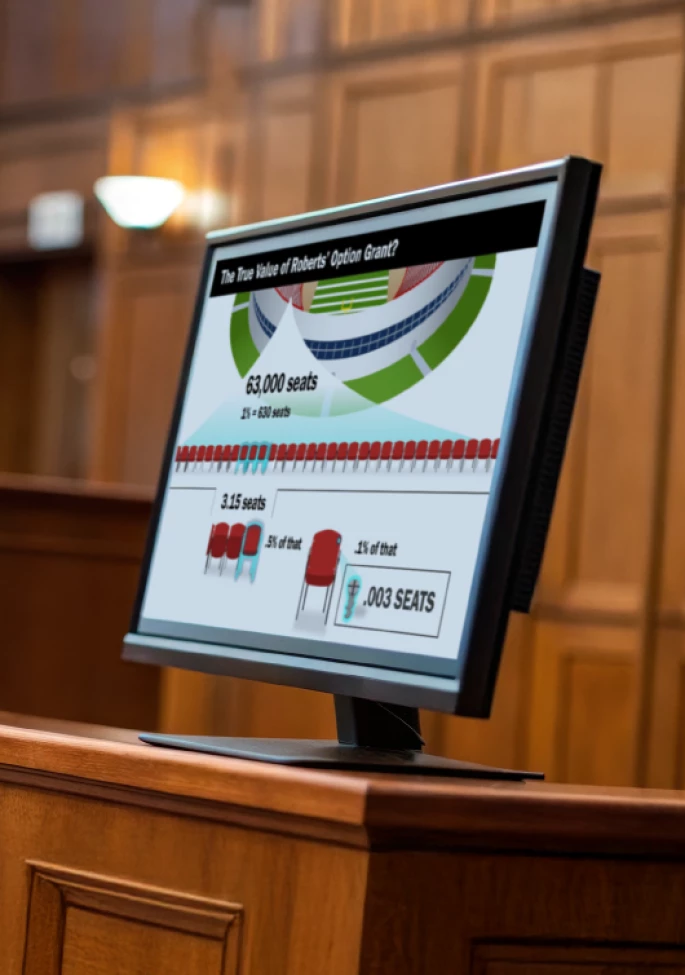In the federal courts, a jury is composed of US citizens from within the federal district in which a court sits. Often, the citizens who make up a jury represent a rich mixture of different races, ethnicities, religions, sexualities, ages, abilities, education levels, and socioeconomic statuses. Because of the variety of people who sit on juries, attorneys must relay their case stories, facts, and arguments in ways that are accessible to all jurors and that all jurors can understand.
This article describes how you can create courtroom designs that are appealing to and useful for a diverse audience.
Design for People’s Physical Limitations
The term “inclusive design” refers to digital designs that are accessible and meaningful for many different types of people. According to Microsoft, “Inclusive design is a methodology born out of digital environments that enables and draws on the full range of human diversity.” Microsoft goes on to explain that inclusive design reflects “how people really are.”
In the courtroom, just like in the larger society, there will be people who have physical challenges. It is ethical practice, benefits your case, and betters the legal system as a whole when you make sure that every juror has access to the information you relay in the courtroom. For instance, your presentation text should be large and clear enough so that all jurors can easily read it. Consider too that some people are color blind, so ensure your images use colors that most people can differentiate. Make allowance for hearing issues as well. Can sound levels be adjusted so that all jurors clearly hear your presentation?
Keep Images Real
Courtroom imagery that reflects the diversity within our society makes viewers feel more included in the judicial process. That is not to say attorneys need to go out on a limb to ensure that every possible type of person existing in society is represented in each visual presentation. You just have to accurately reflect that you and your client are aware that our society is diverse.
Furthermore, it is smart and ethical practice to avoid depicting stereotypes in your graphics. For instance, not all doctors are males, not all nurses are females, not all basketball players are Black, nor is every scientist Asian, etc. Stereotypes exist in our society, and unfortunately, they have sticking power—despite the fact that they are inaccurate and offensive. Your chances of engaging and persuading jurors can decrease immensely if you offend them.
Use Inclusive Metaphors and Analogies
Analogies are an excellent tool for attorneys and expert witnesses to use when they need to explain complex information outside of the realm of most jurors’ day-to-day lives. The analogies and metaphors, however, must also be understandable to a large audience.
Jurors who have never played or watched sports, for instance, are not going to understand your football game analogy. Some jurors who have had little experience playing board games are not going to comprehend how the business deal at the crux of your case is like a game of Stratego. Try to make certain that the metaphors and analogies you use relate to experiences that most people have had. If that goal is not possible, use a variety of analogies to explain the same concept.
Choose Words Carefully
Many commonplace phrases are nefarious stereotypes, or they stem from points in history that remain painfully alive in the consciousness of various groups of people. For instance, referring to a business meeting as a “pow wow” denigrates the cultural significance that term holds for Native Americans. “Sold them down the river” hearkens back to slavery times when masters sent “misbehaving” slaves down the Mississippi River where conditions were especially harsh. “Dumb blondes,” “women drivers,” “paddy wagons”—those terms might seem harmless, but they are not harmless to the people who are the targets of those terms.
You may not always be aware of some of the commonplace phrases that have the power to offend, so it will make sense for you to present your courtroom slides to others before trial in order to gain their insights. For instance, I once had a client who not only wanted to use the term “circle the wagons,” he wanted to display an image of the wagons circling. I had to explain to him that the phrase has its roots in racist perceptions of Indigenous Peoples. He was unaware of the phrase’s negative connotation and was happy to receive that information and be saved from possibly offending a juror.
Don’t Be Afraid to Ask for More Inclusive Designs
Inclusive design must become the norm for courtroom presentations, and therefore, attorneys must be unafraid to ask their graphic designers to use imagery that is real and will resonate with all.
I once had a case in which we depicted a hypothetical negotiation on one of the slides. Both people in the image were Caucasian. The attorney, smartly, considered that the image might be more inclusive if it depicted one person as being non-White. He was, however, very uncomfortable making that request to me. His request went something like this, “So…the guy on the right…can we make…um…can one of them…uhh…have slightly darker…um…a bolder pigment?”
I recognized that he was self-conscious about making a request that pertained to race, and I was appreciative of the fact that he was trying to avoid in any way offending me. By asking for a more inclusive design, he was doing the right thing, however awkward his delivery of that message might have been.
It’s OK to say Black, Brown, and White. It’s OK to ask for a visual representation of someone older or shorter or in a wheelchair. These are the people who make up our society and whose rights, lives, and livelihoods are dependent upon the decisions made in our courtrooms.
The Benefit of Inclusive Trial Graphics
When you show you recognize the diverse backgrounds of your jurors and you strive to be inclusive and respectful, judges and jurors will appreciate your efforts—and your client will benefit. On a larger scale, when you create courtroom imagery that is diverse, inclusive, and accessible, you contribute to creating a legal system that is fair, equitable, and truly designed to serve all people.
This article was originally published in the Fall 2022 issue of USLAW Magazine.







